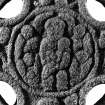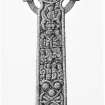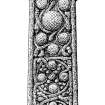Field Visit
Date September 1980
Event ID 1121936
Category Recording
Type Field Visit
Permalink http://canmore.org.uk/event/1121936
ST MARTIN'S CROSS.
The best-preserved of the Early Christian crosses of Iona stands in a stepped granite base some 21 m W of the SW angle of the nave of the abbey church. Its name is first recorded in 1699, in the caption to a sketch by one of Lhuyd's draughtsmen, and although some later writers appear to confuse it with St Matthew's Cross, there is no reason to doubt that it is an authentic medieval designation . Indeed, in view of the high reputation of St Martin of Tours in the early Irish church, attested by his commemoration in the liturgy at Iona in the time of Columba, his name may have been associated with the cross from the time of its erection.
Excavation in 1963 established that the base extends down to an old land-surface at a depth of about 0.8m, where it stands at the E edge of an infilled pit of uncertain origin. It was stated in 1849 that a bronze spoon was discovered underneath the cross when it was re-erected after falling, but there may be some confusion with St Matthew's Cross, which was prostrate at that time, and there is no other evidence that St Martin's Cross has ever been removed from its socket. As early as 1749 it was noted that the cross was 'overgrown with fog (moss)', and a thick growth of lichen was removed shortly before 1860. The cross was again cleaned in 1973 to allow geological identification and to facilitate photography in connection with the present survey.
The cross is carved from a single block of grey epidiorite of Dalradian age, probably imported from the 'green beds' of the Argyll mainland. This material is particularly intractable, and did not permit the precise setting-out or delicate carved detail seen on St John's Cross. It measures 4.3m in height, excluding a tenoned butt of unknown length concealed in the cross-socket, by 0·67m in width at the base, tapering to 0.55m at the cross-head , and is 0.26m in maximum thickness tapering to 0.20m at the apex.
It is suggested on RCAHMS 1982 pp. 17-19 that St Martin's Cross belongs to about the middle or the second half of the 8th century, and that it is the latest of the 'Iona group' of crosses.
RCAHMS 1982, visited September 1980
See RCAHMS 1982, 204-8, No. 6 (83) for a full description of the cross, and 214, No. 6 (97) for a description of the base.













